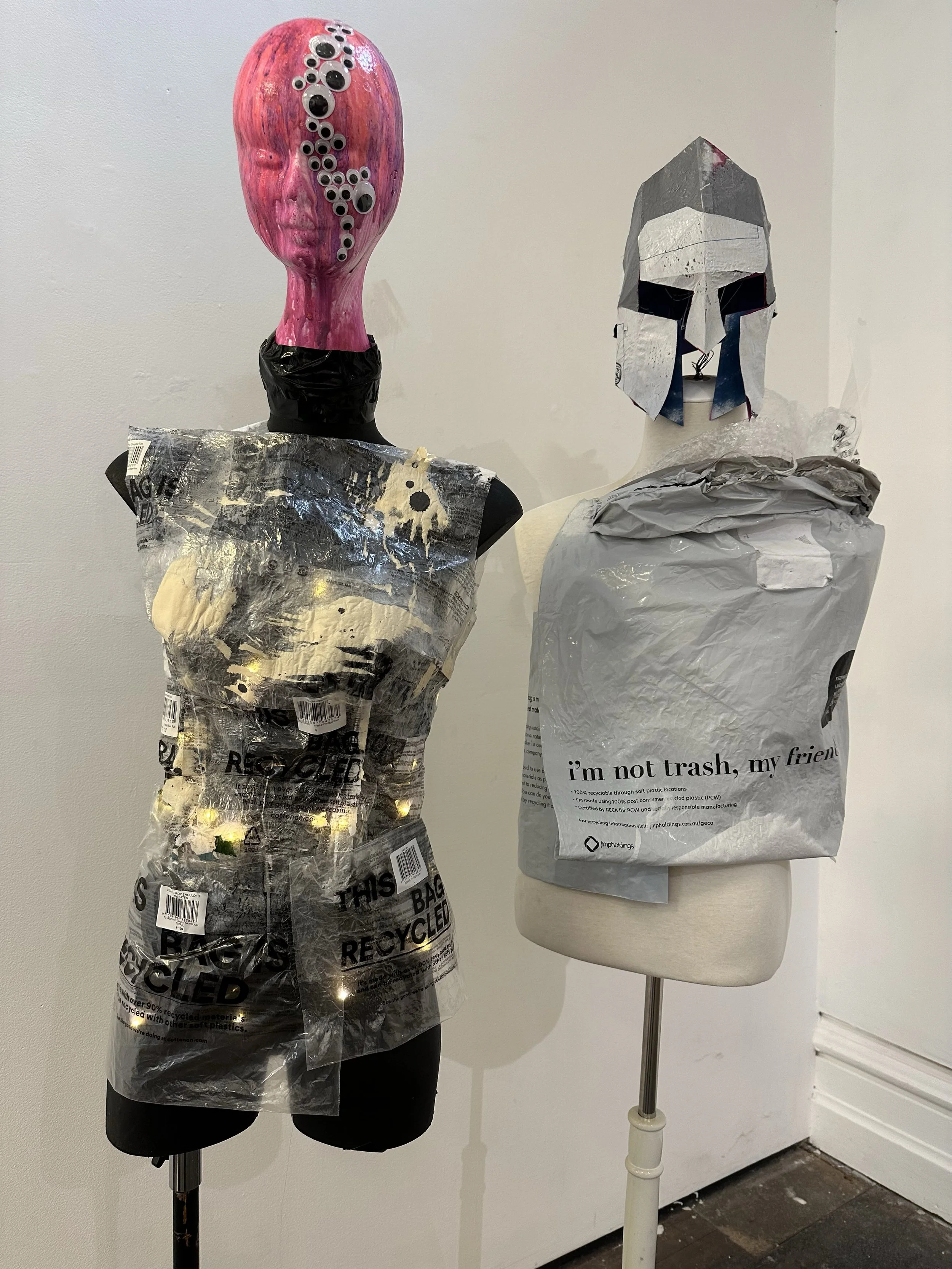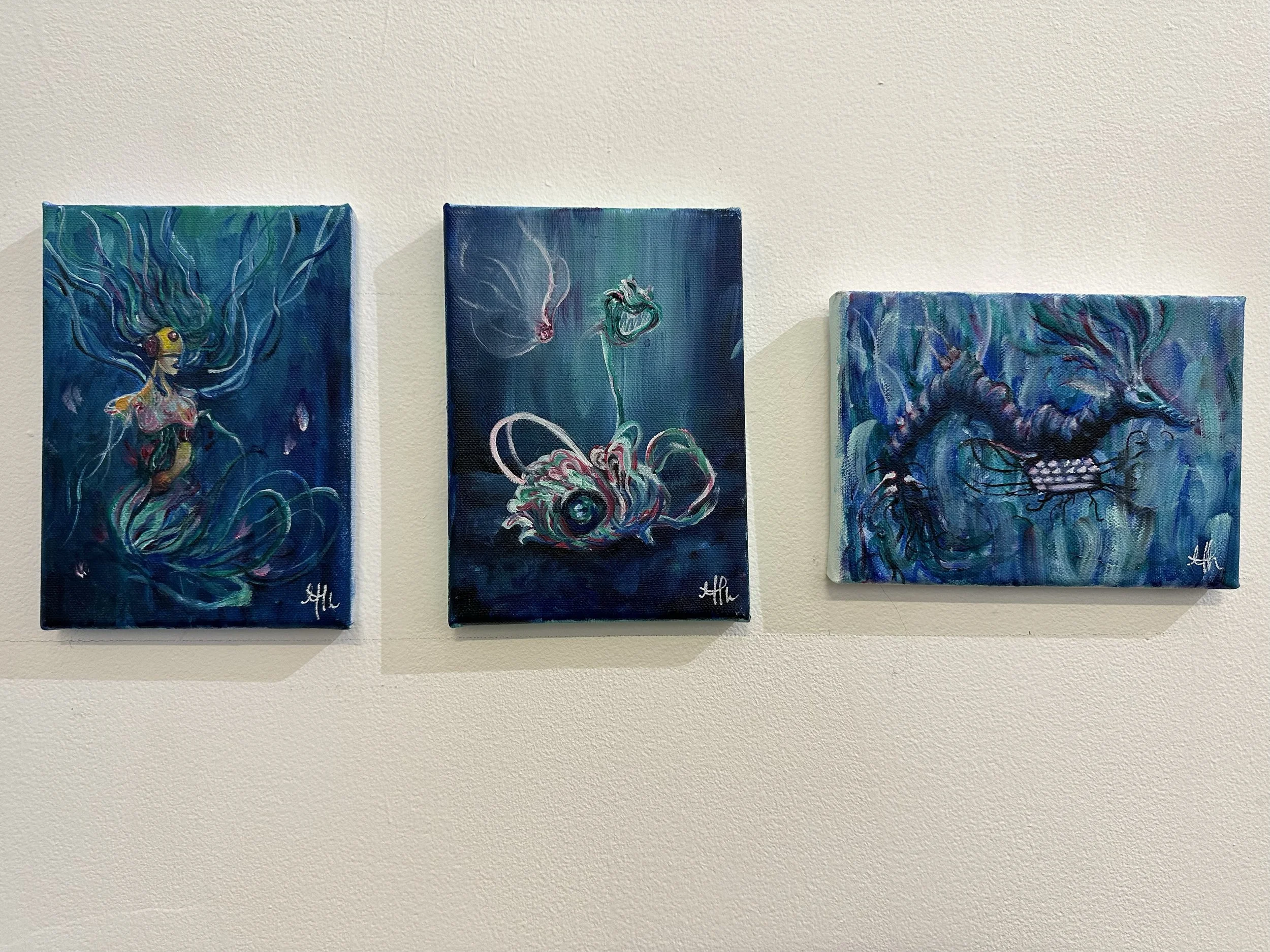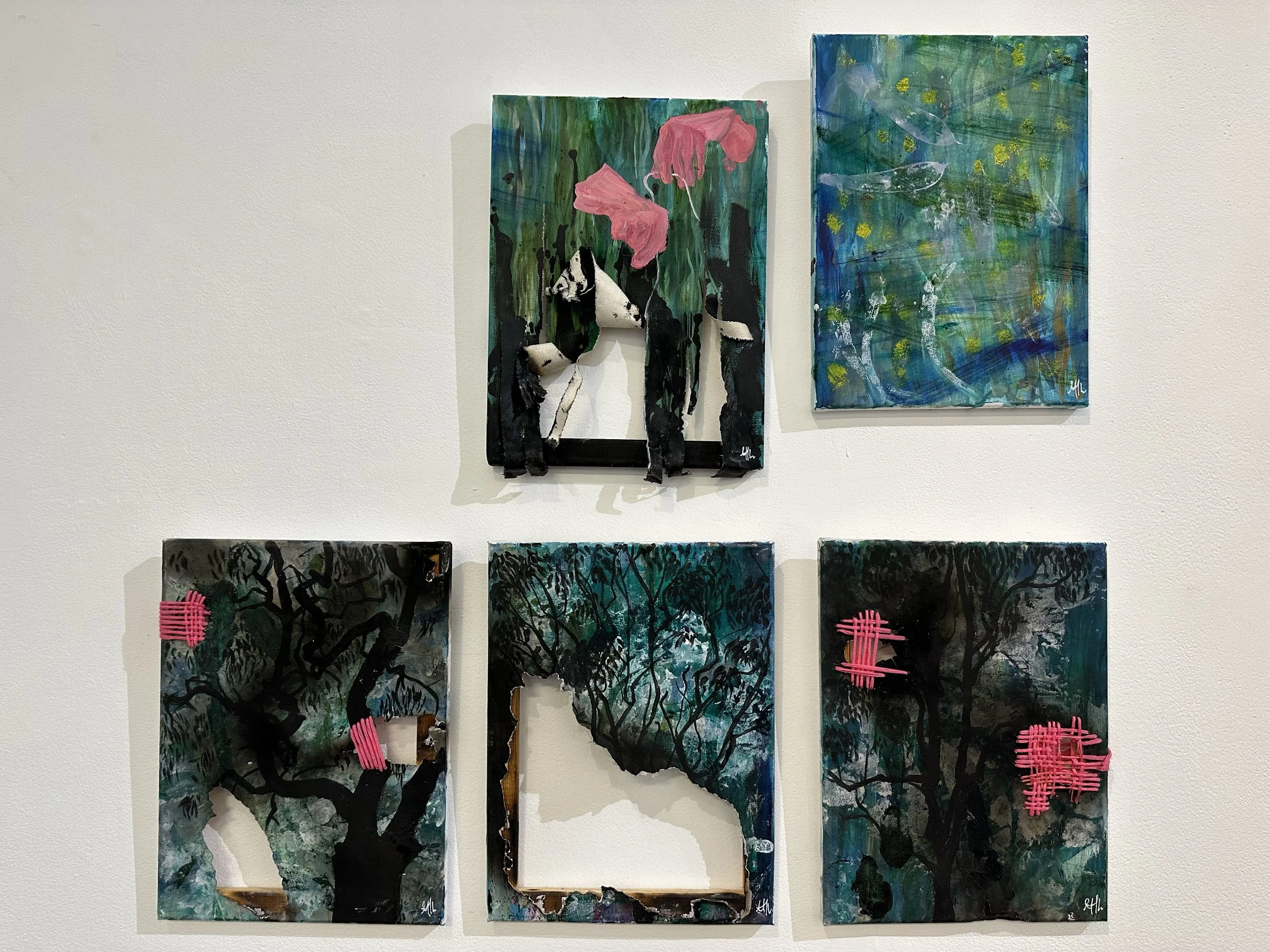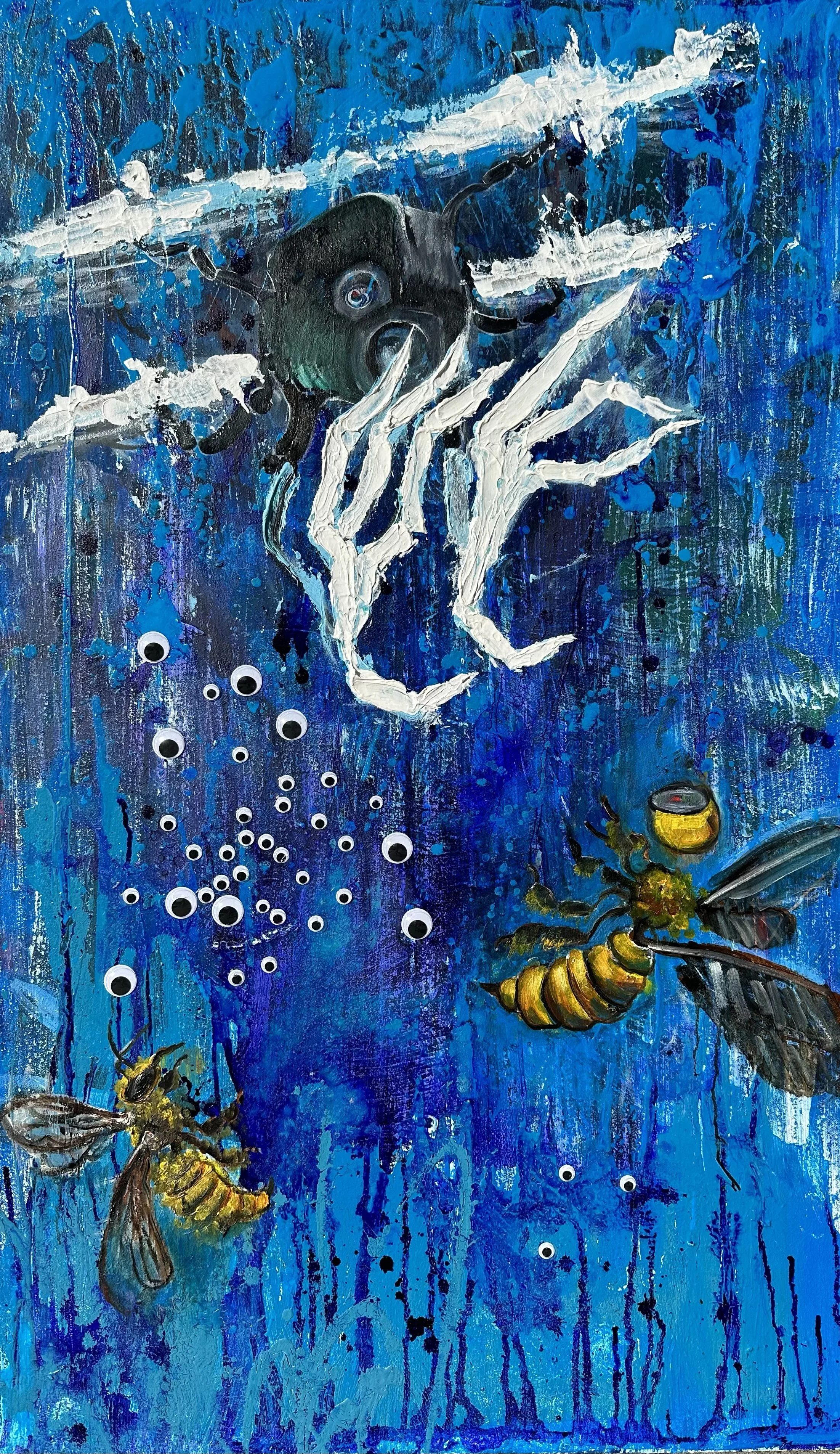Midnight in the Garden is a work in progress. It’s an attempt to channel powerful emotions of climate grief and shame, and confront the infiltration of technology and its junk into all corners of the natural world. It asks how we find solace in a dying world, act from a position of moral compromise, and bear responsibility for the ongoing realities of colonisation.
Embracing generative AI technologies and traversing oil painting, textile sculpture, and creative coding, the exhibition is a cathartic whirlwind of surrealist works depicting our beautiful and broken dystopia.
For many years I’ve grappled with finding a visual and symbolic language that speaks to my deep feelings of moral compromise, climate grief, alienation from the natural world, and the overwhelming scale and reach of capital. The poetic opportunities and accidents of generative AI technology has been a profound and liberating creative force, allowing rapid investigation of visual ideas.
In turn, after many years of technology based works, I’ve been inspired to return to the rich texture of oil painting to further explore the imagery suggested by AI tools.
It’s my hope that the resulting works are a discomfiting blend of beauty and sorrow, inviting meditation on the deep sense of unease about our place in the world that many of us carry within.
Works
AI generated images on Instax Fujifilm, 35 x 40 cm
This is a series of AI generated images on the theme of dead malls. The back rooms. SCP. Failed spaces of capitalism that we wander like acquisitive ghouls. More beautiful and haunting and appealing in the aftermath. Failed dreams and unfulfilled promises. Our fascination with future dystopia. Rising sea levels, sinking middle class. Children confined to online spaces without even the measly public square of shopping centres to congregate. Isolation. Online commerce. Amazon warehouses.
This bag is recycled & I’m not trash my friend
Textile sculpture, soft plastics and various materials, c. 200 x 50 x 50cm each
When the soft plastics recycling scheme fell over in Victoria. I started collecting soft plastics. Ironing them together, using pleat moulds from old theatre projects. Not many of these plastics work well as textiles - garish, too stiff, not melty enough.
The ones that worked the best were garment bags. Lightweight and blowsy like their contents. Flimsy and dissolvable.
All this plastic screams lies at us. Cognitive dissonance. Direct orders not to think. Because we know about factories in Bangladesh and how thirsty cotton is and micro plastic micro fibres in our water, in our fish, in our children. But we also need to be clothed. So the plastic reassures us.
Soft and sustainable. This bag is recycled. I’m not trash my friend.
And at the back of my mind I’m thinking of sentinels that rose out of the mist of the museum of Innsbruck. Helms proud as chainmail dissolves. Plastic will last an eternity longer.
Plastic oceans
Series of three paintings, oil on canvas, 15 x 21cm, 15 x 21cm, 21 x 15cm
What to say? It’s everywhere. The sea heaves with it. More plastic than fish.
Burnt forests
Series of five paintings, oil and acrylic on canvas, polyester yarn, charcoal, 21 x 30cm each
I left Australia in the wake of the Black Saturday fires.
I came back to Australia, pregnant, to an El Niño summer. I sat in my lounge room, belly huge, power out, hiding from 45 degree heat, watching emergency updates on Twitter. The whole country a disaster zone. Koalas screamed in the night.
And all the people, all the women, were shocked and saddened and grieving, and went running out against the reddened sky to meet the catastrophe with all the tools of civil society to fix it and to help and to make it better.
But no amount of cake stalls and sewing bees and silent auctions and food drives is going to be enough. The mends won’t hold.
An earth only safe to touch wearing pink gloves and PPE.
Surveillance skies
Oil and acrylic on canvas, 60 x 120cm
One summer in Berlin there was a wasp nest in our courtyard. They grew steadily more frenetic. By August we had to keep our third floor window closed at night as they pelted themselves against the light. So many and so incensed it sounded like hail.
My honeymoon love affair with tech had been brought crashing to earth by the Snowden revelations; the internet wasn’t the vast sea of untraceable, uncontrollable, identity wheeling freedom that had beckoned me since teenagerhood.
It was bounded, physical, great heaving water guzzling server factories, engorged pipelines of private data draped across the ocean floor. It belonged, like everything else, to the American powerful. The panopticon.
And at the same time doxxing and gamergate and the hounding of Julia Gillard and swatting. How chilling on my political activity.
Flooded earth
Oil and acrylic on canvas, 50 x 50cm
The final piece in this series of the four elements of the world. But all the elements are wrong, wronged, befouled.
The time is out of joint.
Maps, aerial views, drone footage give way to meaningless mud brown abstraction as waters flood over Lismore.
A year later, families still in tents and children with PTSD.
The arrival
Oil, acrylic and enamel on canvas, 101 x 152cm
Inspired by AI generated images, I just kept thinking about the documentary Czech Dream, in which 3,000 people go running across a plain to a fake hypermarket, gradually realising they’re being mocked.
Midnight in the garden
Oil and acrylic on canvas, 101 x 152cm
I asked AI to draw midnight in the gardens of capitalist realism and this is what it showed me.
The awe and drama and intoxicating promise and power of the industrial dawn.
Or is the sunset on our dreams of progress?
Death cult of productivity
Series of nine prints, AI and Processing generated images, giclee prints on Ilford soft rag archival paper, each signed print is in an edition of five, 30 x 42cm each
The antiwork Facebook group is a potent blend of consciousness raising, job interview tips, and howls of utter despair. I lifted wholesale from there the phrase “death cult of productivity”.
When I plugged it into Midjourney, what came out was like the caffeine fuelled fever dream of an illustrator for The Economist who has hustled and grinded a few too many gig economy jobs since they were last able to send off an invoice.
Buy your kids a job
Oil, acrylic, plaster and yarn on canvas, 101 x 63cm
Australia rides on the sheep’s back. The kangaroo and the emu are our national symbols because they are the only animals that can’t walk backwards. That factoid is inaccurate but that won’t stop us from refusing to look at our history. The slogan buy your kids a job didn’t save Aussie manufacturing but it has a whole ironic afterlife in the era of nepo babies.
Shearing the rams
Oil, acrylic and plaster on canvas, 101 x 63cm
Tom Roberts worked hard to depict how the dust rose in the sunlight.
The factories will not stop until all the stuff of the earth is churned and processed and converted into pink slime.
White tears
Triptych, oil and acrylic on canvas, 100 x 70cm
In this painting the figure is riven with shame, literally wishing to disconnect from what her hands have wrought. She cries tears of penance, but those very white tears are the problem; the centring of white pain is toxic to the landscape. There is no way to connect, every touch is death.
This work is about the time I spent in Barmah Forest, and what I learned from Yorta Yorta people there. And it’s about mass fish death on the Murray. And white fragility. And shame and guilt. And discovering the truth about this colony as an adult and finding it almost too much to bear.
Gary Foley said it is up to white people to talk about racism. Talk amongst ourselves. Just as men should speak about feminism.
But it was very hard when I first heard the terms white feminism and white fragility and white tears. To be suddenly othered from the outside. To be criticised. Becky.
But these feelings of shame and guilt and discomfort are not too much to bear. They must be carried and borne. The only way out is through and on the other side is adulthood, maturity, acceptance of responsibility, and sorrow.
I felt I had no public examples for walking this journey. It’s not Aboriginal people’s responsibility to carry or minimise or erase or ease the burden of our guilt. It’s ours to resolve, and to act upon.
Our inability to face these emotions is manifest politically and socially as denial, extremism, conspiracy theory, do goodism, middle class hand wringing, performative allyship. As both the vilest and the most insidious forms of racism.
I’m far from perfect. But we have to start somewhere.












